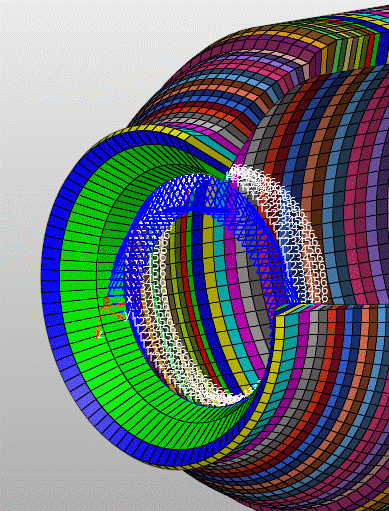Overview
The Laminated Solid model (_SOL) has one solid (brick) element through the thickness. These elements have a laminate structure built up of all the layers at that position. In some cases and systems this may be a better model than a basic shell model without incurring a significant penalty in terms of computational speed. This type of model will have a similar number of elements as a shell model but double the number of nodes and hence is likely to have more degrees of freedom compared to a shell model of similar resolution. If the loading and constraints are purely axisymmetric it is probably quicker and more computationally efficient analysis can be made using the Cadfil cyclic symmetry model (_CYSYM) which models a wedge shaped slice of the full model with cyclic symmetric boundary condition. The models structure is built up of 8 node brick elements with one element through the total thickness. Within the element each filament wound layer (FWL) has 2 or 4 distinct plies that is equal thickness plus and minus angle plies for that FWL. There is a user option to set 2 or 4 plies per FWL, +- or +--+. The 4 ply option gives more through thickness integration points and more symmetric. In some instances and systems this may give more detailed results. The formulation of the elements and the physical assumptions/approximations is dependant on the analysis system chosen and the element type/designation used in that system.


Cadfil Solver Support
Cadfil support for shell models is primarily via the flavours pull down menu. The current selections are MSC Nastran, NX Nastran (Simcenter), Optistruct (Altair), LS-DYNA and ABAQUS. All of these generically have similar sets of model features, and the output is in the form of a native data-deck. In most cases where standard pressure loads and boundary conditions are requested data decks that are complete and can be sent straight to the solver can be created for static analysis. There is also the optional features to add Hypermesh comments to the deck that can structure the data deck for easier review and manipulation in the Altair Hypermesh software.
Using imported FEA geometry.
Cadfil can as import basic FEA geometry (nodes and shell elements) that is geometrically compatible with and existing filament winding data set and add the Material, thickness, fibre architecture and boundary conditions. The imported model can be made of tris, quads or a mix. This method is useful where the analysis requires some specific mesh detailing. A common applications is tanks that have a number of holes for side ports. Cadfil will find all such holes and create named node sets. Openingings that correspond to circular end ports will get standard boundary conditioned added, all the features listed below are supported. Models supported for import include Nastran bulk data decks and LS-DYNA keyword decks.
Standard Laminated solid (_SOL) Model Features for supported solver flavours.
Cadfil can produce complete standard data decks that can be sent straight to the solvers with no further work needed. Due to the different capabilities of different solver's data input modules the data decks are all different in many ways but the core features are:
- Node/grid Coordinates
- Brick element topology with 8 node
- Axis systems for BCs and for Elements/Materials as needed
- Laminate Section descriptions with global ply numbering
- Axial and tangential restraint at first polar opening
- Tangential restraint at second polar opening (if present) or at symmetry boundary if a half model
- element internal surface definition for pressure load
- Internal pressure load
- Axial Equivalent point loads at nodes on second polar opening (if present) to simulate pressure load on end boss/plug
- Individual Names Node sets for openings
- Orthotropic material data from Cadfil data base or user supplied include file
- Standard Loading/time curve/loading steps where appropriate for solver.
- Job control from supplied include file that can be user customised and optimised for needs
- Extensive data deck comments and full traceability of Cadfil FEA parameters used.
- Option for extensive Hypermesh comments to organise data in Altair Hypermesh